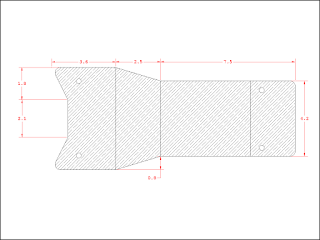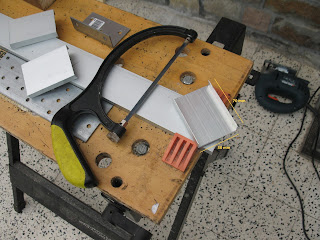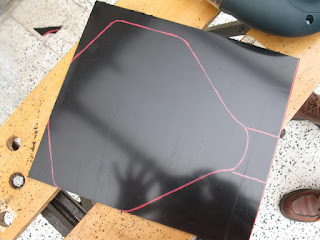So far I've spent much of the time on mechanics rather than the electronics. But, I'm not in a hurry and try to get the joy of doing things slow but steady. The chassis is almost done, I'll add some handles and maybe some protective rubber caps, just in case it decides to run away and hit somewhere.
This is the story of my pet robot. The idea came to mind when my sons relentless begging for owning a dog drived me crazy. Instead of having a dog I decided to make one :)
Friday, October 18, 2013
Friday, October 11, 2013
I have two stock motors from Parallax, they are 7.2 volt and 310 rpm. My concern is that they are a little bit faster than I want them to be. I see that many people replace them, anyway. I'd prefer torque over speed, and I think a higher gear ratio will make it more stable. BTW, I'd like to thank Erco for finding the lower rpm replacement motors on Ebay. I guess I'll use the similar ones which are 70 rpms but 12 volt. I don't know yet if my 6 cells 7.2 volt NIMh battery pack would provide enough juice for them.
Monday, October 7, 2013
After a few busy weeks, found some time to work on my robot again. I brushed the aluminum tail that I cut from 2 mm sheet. It looked straightforward in the video I mentioned previously, but believe me it is a long and laborious process. It took me almost half an hour just to brush one side with 180 grade sand paper. The pictures were taken ten minutes apart.
Wednesday, October 2, 2013
The tail assembly would become sturdier if there is a support from the buttom upward. And here is he solution. It's the same kind of aluminum, 2 mm thick. Cut and filed by manual tools.
I have nothing but an old vise to use for bending. But the trick is; first make a groove around (0.5 mm) on the plate where you want to bend with a dremel cutting disc, and then bend it slowly. Before bending, I made some brushing with 240 grit sand paper. I'm very happy with the result, it's just great, isn't it?
I have nothing but an old vise to use for bending. But the trick is; first make a groove around (0.5 mm) on the plate where you want to bend with a dremel cutting disc, and then bend it slowly. Before bending, I made some brushing with 240 grit sand paper. I'm very happy with the result, it's just great, isn't it?
Thursday, September 26, 2013
Monday, September 23, 2013
Side panels are almost ready, I think I'm going to use the stock motor mounts that comes with Parallax motors. I want my robot a little high on the ground then maybe it can go outdoor and hairy carpets won't be a problem. For that, I designed the height as 50 mm, plenty enough to put the battery, motor controllers and obviously the motors in the chassis.
Wednesday, September 18, 2013
Now, It's time to focus on Stingray's tale. Since I use Parallax caster wheel I need to make a mount for the wheel which attaches to the chassis. Pictures tell much more than words,
I cut this piece from an aluminum sheet that is 2 mm thick,
At the final stage, after drilling and happy with the result, I will give the brushed aluminum effect manually, this is the how to video on youtube.
I cut this piece from an aluminum sheet that is 2 mm thick,
At the final stage, after drilling and happy with the result, I will give the brushed aluminum effect manually, this is the how to video on youtube.
Saturday, September 14, 2013
And the side panels, as I said these are made out of aluminum,
I also prepared a template for the bolt holes to make sure that each side panel has the exact same drill pattern,
I had some concerns that the aluminum profile was too thin (1 mm) but having had no alternative after some experiment it turned out to be fairly sturdy, especially after the bolts are done.
I also prepared a template for the bolt holes to make sure that each side panel has the exact same drill pattern,
I had some concerns that the aluminum profile was too thin (1 mm) but having had no alternative after some experiment it turned out to be fairly sturdy, especially after the bolts are done.
Thursday, September 5, 2013
I feel so jealous of the ones who have access to a laser cutter. This could have been much easier with a laser cutter, although I'm not sure about the outcome with HDPE on a laser cutter.
Anyway, with the help of my wife we first raw cut and do the fine trimming with dremel. I must admit she has done much of the work.
Anyway, with the help of my wife we first raw cut and do the fine trimming with dremel. I must admit she has done much of the work.
Subscribe to:
Posts (Atom)




